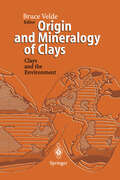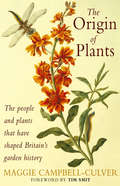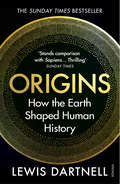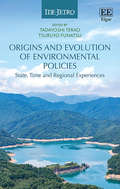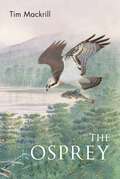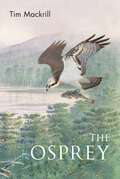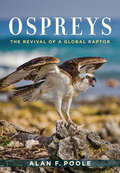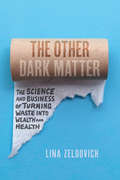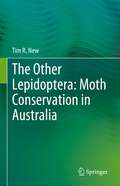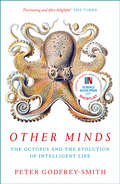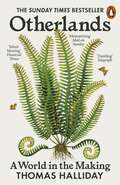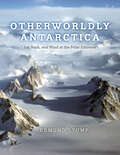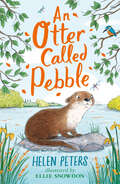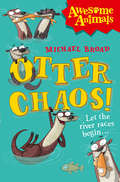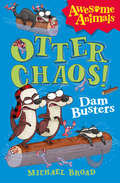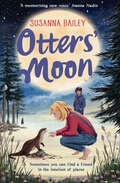- Table View
- List View
Origin and Evolution of Caribbean Mangroves: A Time-Continuum Ecological Approach (Ecological Studies #252)
by Valentí RullThis book provides a comprehensive, detailed, and coherent spatio-temporal account of Caribbean mangrove evolution from its evolutionary origins to the present that is not available for any mangrove region in the world. Mangroves are intertidal wetland forests that play a crucial role in the maintenance of terrestrial and marine biodiversity, and in the functioning of global biogeochemical cycles (especially the carbon cycle). These ecosystems dominate the tropical/subtropical coasts of all continents and are among the most threatened ecosystems in the world. This book combines all temporal scales, from the geological to the ecological, to provide an integrated picture of mangrove history and the natural and anthropogenic drivers of ecological and evolutionary change. This may be useful not only for understanding the current ecological status of these emblematic ecosystems, but also for informing their conservation in the face of ongoing global change.
Origin and Mineralogy of Clays: Clays and the Environment
by BruceVeldeOrigin and Mineralogy of Clays, the first of two volumes, lays the groundwork for a thorough study of clays in the environment. The second volume will deal with environmental interaction. Going from soils to sediments to diagenesis and hydrothermal alteration, the book covers the whole spectrum of clays. The chapters on surface environments are of great relevance in regard to environmental problems in soils, rivers and lake-ocean situations, showing the greatest interaction between living species and the chemicals in their habitat. The book is of interest to scientists and students working on environmental issues.
The Origin of Clay Minerals in Soils and Weathered Rocks
by Bruce B. Velde Alain MeunierOf huge relevance in a number of fields, this is a survey of the different processes of soil clay mineral formation and the consequences of these processes concerning the soil ecosystem, especially plant and mineral. Two independent systems form soil materials. The first is the interaction of rocks and water, unstable minerals adjusting to surface conditions. The second is the interaction of the biosphere with clays in the upper parts of alteration profiles.
The Origin Of Plants: The People And Plants That Have Shaped Britain's Garden History
by Maggie Campbell-CulverA fascinating history of Britain's plant biodiversity and a unique account of how our garden landscape has been transformed over 1000 years, from 200 species of plant in the year 1000 to the astonishing variety of plants we can all see today. Thousands of plants have been introduced into Britain since 1066 by travellers, warriors, explorers and plant hunters - plants that we now take for granted such as rhododendron from the Far East, gladiolus from Africa and exotic plants like the monkey puzzle tree from Chile.Both a plant history and a useful reference book, Maggie Campbell-Culver has researched the provenance and often strange histories of many of the thousands of plants, exploring the quirky and sometimes rude nature of the plants, giving them a personality all of their own and setting them in their social context. The text is supported by beautiful contemporary paintings and modern photographs in 2 x 8 pp colour sections.
Origins: How the Earth Shaped Human History
by Lewis DartnellRead the Sunday Times bestseller that reveals the Earth's awesome impact on the shape of human civilisations.'Stands comparison with Sapiens... Thrilling' Sunday Times Human evolution in East Africa was driven by geological forces. Ancient Greece developed democracy because of its mountainous terrain. Voting behaviour in the United States today follows the bed of an ancient sea. Professor Lewis Dartnell takes us on an astonishing journey into our planet's past to tell the ultimate origin story. Blending science and history, Origins reveals the Earth's awesome impact on the shape of human civilisations - and helps us to see the challenges and opportunities of the future. 'A sweeping, brilliant overview of the history not only of our species but of the world' Peter Frankopan, author of The Silk Roads 'Absorbing... A first-class read - and an important one' Observer
Origins and Evolution of Environmental Policies: State, Time and Regional Experiences
This unique book traces the origins and evolution of environmental policy formation, comparing the differences in this process between developing and developed countries. It focuses on the importance of the state’s role and issues of timing and sequence in the creation of environmental policies. Expert contributors provide new insights into how the environment as a concept and environmental policies have evolved. They analyse how ‘latecomer public policy’ is related to the dilemma between industrial development and maintaining high environmental standards, especially in developing countries. Chapters also examine these processes in a variety of regions with rich records of environmental policies and trajectories of change. Taking a historical and path dependence approach, the book emphasises the significance of the role of administrative systems, policy coordination and timing in the success or failure of environmental policies. This book will be a valuable resource for academics and students of environmental studies, public policy, public administration and regional studies. Its synthesis of empirical data and case studies from countries including China, Taiwan, Thailand, the US and Germany will also be beneficial for policymakers.
Orphan Crops for Sustainable Food and Nutrition Security: Promoting Neglected and Underutilized Species (Issues in Agricultural Biodiversity)
by Danny Hunter Stefano Padulosi E.D. Israel Oliver King M. S. SwaminathanOrphan Crops for Sustainable Food and Nutrition Security discusses the issues, challenges, needs and opportunities related to the promotion of orphan crops, known also as neglected and underutilized species (NUS). The book is structured into six parts, covering the following themes: introduction to NUS, approaches, methods and tools for the use enhancement of NUS, integrated conservation and use of minor millets, nutritional and food security roles of minor millets, stakeholders and global champions, and, building an enabling environment. Presenting a number of case studies at the regional and country levels, the chapters cover different but highly interlinked aspects along the value chains, from acquisition and characterization of genetic diversity, cultivation and harvesting to value addition, marketing, consumption and policy for mainstreaming. Cross-cutting issues like gender, capacity building and empowerment of vulnerable groups are also addressed by authors. Representatives from communities, research for development agencies and the private sector also share their reflections on the needs for the use enhancement of NUS from their own perspectives. This book will be of great interest to students and scholars of food security, sustainable agriculture, nutrition and health and development, as well as practitioners and policymakers involved in building more resilient food and production systems.
Orphan Crops for Sustainable Food and Nutrition Security: Promoting Neglected and Underutilized Species (Issues in Agricultural Biodiversity)
by Danny Hunter Stefano Padulosi M. S. Swaminathan E. D. Israel Oliver KingOrphan Crops for Sustainable Food and Nutrition Security discusses the issues, challenges, needs and opportunities related to the promotion of orphan crops, known also as neglected and underutilized species (NUS). The book is structured into six parts, covering the following themes: introduction to NUS, approaches, methods and tools for the use enhancement of NUS, integrated conservation and use of minor millets, nutritional and food security roles of minor millets, stakeholders and global champions, and, building an enabling environment. Presenting a number of case studies at the regional and country levels, the chapters cover different but highly interlinked aspects along the value chains, from acquisition and characterization of genetic diversity, cultivation and harvesting to value addition, marketing, consumption and policy for mainstreaming. Cross-cutting issues like gender, capacity building and empowerment of vulnerable groups are also addressed by authors. Representatives from communities, research for development agencies and the private sector also share their reflections on the needs for the use enhancement of NUS from their own perspectives. This book will be of great interest to students and scholars of food security, sustainable agriculture, nutrition and health and development, as well as practitioners and policymakers involved in building more resilient food and production systems.
Osha Laboratory Standard - Implementation Guide
by Richard EnnisThis manual contains four major components: 1) An easy-to-follow discussion of the Standard's requirements, along with a plan for implementing management responsibilities; 2) A fill-in schedule for assigning key responsibilities and establishing deadlines; 3) A copy of the OSHA Lab Standard for easy reference; 4) A Chemical Hygiene Plan that has been developed in accordance with the requirements of paragraph (e) of the Standard.
Osha Laboratory Standard - Implementation Guide
by Richard EnnisThis manual contains four major components: 1) An easy-to-follow discussion of the Standard's requirements, along with a plan for implementing management responsibilities; 2) A fill-in schedule for assigning key responsibilities and establishing deadlines; 3) A copy of the OSHA Lab Standard for easy reference; 4) A Chemical Hygiene Plan that has been developed in accordance with the requirements of paragraph (e) of the Standard.
The Osprey (Poyser Monographs)
by Mr Tim MackrillA highly readable Poyser monograph on one of the most widespread raptors.The Osprey is a large, fish-eating bird of prey. Distinctively marked in deep brown and white, with a piercing yellow eye and powerful hooked bill, the Osprey snatches its prey in spectacular swoops above lakes and wetlands around the world – it is one of the most widespread of all birds. Persecuted mercilessly in Britain, it became extinct in the 1890s before returning to the famous Loch Garten in Scotland in the 1950s. The return of the bird has been slow, but reintroduction programmes elsewhere – notably at Rutland Water – have been successful, and this remarkable raptor is an increasingly common sight in our skies. This Poyser monograph is dedicated to this fine species and includes more than 150 colour photographs. The Osprey looks at the distribution, foraging ecology, migration, breeding behaviour and population dynamics of this spectacular bird, with emphasis placed on conservation efforts both in Britain and in the species' African haunts, which have been discovered only very recently thanks to advances in satellite tagging technology.
The Osprey (Poyser Monographs)
by Mr Tim MackrillA highly readable Poyser monograph on one of the most widespread raptors.The Osprey is a large, fish-eating bird of prey. Distinctively marked in deep brown and white, with a piercing yellow eye and powerful hooked bill, the Osprey snatches its prey in spectacular swoops above lakes and wetlands around the world – it is one of the most widespread of all birds. Persecuted mercilessly in Britain, it became extinct in the 1890s before returning to the famous Loch Garten in Scotland in the 1950s. The return of the bird has been slow, but reintroduction programmes elsewhere – notably at Rutland Water – have been successful, and this remarkable raptor is an increasingly common sight in our skies. This Poyser monograph is dedicated to this fine species and includes more than 150 colour photographs. The Osprey looks at the distribution, foraging ecology, migration, breeding behaviour and population dynamics of this spectacular bird, with emphasis placed on conservation efforts both in Britain and in the species' African haunts, which have been discovered only very recently thanks to advances in satellite tagging technology.
Ospreys: The Revival of a Global Raptor
by Alan F. PooleOspreys are one of the few bird species that are found throughout the world. From forests in Hokkaido to rivers in Oregon and islands off Australia, Ospreys steal the show as nature lovers easily watch them build their massive nests and tend to their young. The fact that the Osprey is one of the few large birds that can hover adds to its mystique, and to watch it plunge into the water, emerging with a fish clutched in its talons, is truly a sight one will remember. As widespread as Ospreys are, not long ago they were under threat of extinction. During the 1950s and '60s, scientists tied the decline of Osprey populations to the heavy use of DDT and other human pollutants. In the 1980s, Ospreys began a slow recovery due to the efforts of conservationists and through the resilience of the adaptable raptors themselves. Today they are again considered common in most parts of the world, although some populations remain threatened.In this gorgeously illustrated book, Alan F. Poole, one of America's premier Osprey experts, has written a lyrical expos;© of these majestic creatures, describing their daily habits and exploring their relationship with the environment. Ospreys celebrates the species' miraculous recovery from contaminants and hunters, chronicles their spectacular long-distance migrations, and unveils their vital role in bringing life to coastal habitats. Few other birds have such a hold on the human imagination. This book shows us why.
Ospreys: The Revival of a Global Raptor
by Alan F. PooleOspreys are one of the few bird species that are found throughout the world. From forests in Hokkaido to rivers in Oregon and islands off Australia, Ospreys steal the show as nature lovers easily watch them build their massive nests and tend to their young. The fact that the Osprey is one of the few large birds that can hover adds to its mystique, and to watch it plunge into the water, emerging with a fish clutched in its talons, is truly a sight one will remember. As widespread as Ospreys are, not long ago they were under threat of extinction. During the 1950s and '60s, scientists tied the decline of Osprey populations to the heavy use of DDT and other human pollutants. In the 1980s, Ospreys began a slow recovery due to the efforts of conservationists and through the resilience of the adaptable raptors themselves. Today they are again considered common in most parts of the world, although some populations remain threatened.In this gorgeously illustrated book, Alan F. Poole, one of America's premier Osprey experts, has written a lyrical expos;© of these majestic creatures, describing their daily habits and exploring their relationship with the environment. Ospreys celebrates the species' miraculous recovery from contaminants and hunters, chronicles their spectacular long-distance migrations, and unveils their vital role in bringing life to coastal habitats. Few other birds have such a hold on the human imagination. This book shows us why.
The Other Dark Matter: The Science and Business of Turning Waste into Wealth and Health
by Lina ZeldovichGrossly ambitious and rooted in scientific scholarship, The Other Dark Matter shows how human excrement can be a life-saving, money-making resource—if we make better use of it. The average person produces about four hundred pounds of excrement a year. More than seven billion people live on this planet. Holy crap! Because of the diseases it spreads, we have learned to distance ourselves from our waste, but the long line of engineering marvels we’ve created to do so—from Roman sewage systems and medieval latrines to the immense, computerized treatment plants we use today—has also done considerable damage to the earth’s ecology. Now scientists tell us: we’ve been wasting our waste. When recycled correctly, this resource, cheap and widely available, can be converted into a sustainable energy source, act as an organic fertilizer, provide effective medicinal therapy for antibiotic-resistant bacterial infection, and much more. In clear and engaging prose that draws on her extensive research and interviews, Lina Zeldovich documents the massive redistribution of nutrients and sanitation inequities across the globe. She profiles the pioneers of poop upcycling, from startups in African villages to innovators in American cities that convert sewage into fertilizer, biogas, crude oil, and even life-saving medicine. She breaks taboos surrounding sewage disposal and shows how hygienic waste repurposing can help battle climate change, reduce acid rain, and eliminate toxic algal blooms. Ultimately, she implores us to use our innate organic power for the greater good. Don’t just sit there and let it go to waste.
The Other Dark Matter: The Science and Business of Turning Waste into Wealth and Health
by Lina ZeldovichGrossly ambitious and rooted in scientific scholarship, The Other Dark Matter shows how human excrement can be a life-saving, money-making resource—if we make better use of it. The average person produces about four hundred pounds of excrement a year. More than seven billion people live on this planet. Holy crap! Because of the diseases it spreads, we have learned to distance ourselves from our waste, but the long line of engineering marvels we’ve created to do so—from Roman sewage systems and medieval latrines to the immense, computerized treatment plants we use today—has also done considerable damage to the earth’s ecology. Now scientists tell us: we’ve been wasting our waste. When recycled correctly, this resource, cheap and widely available, can be converted into a sustainable energy source, act as an organic fertilizer, provide effective medicinal therapy for antibiotic-resistant bacterial infection, and much more. In clear and engaging prose that draws on her extensive research and interviews, Lina Zeldovich documents the massive redistribution of nutrients and sanitation inequities across the globe. She profiles the pioneers of poop upcycling, from startups in African villages to innovators in American cities that convert sewage into fertilizer, biogas, crude oil, and even life-saving medicine. She breaks taboos surrounding sewage disposal and shows how hygienic waste repurposing can help battle climate change, reduce acid rain, and eliminate toxic algal blooms. Ultimately, she implores us to use our innate organic power for the greater good. Don’t just sit there and let it go to waste.
The Other Lepidoptera: Moth Conservation in Australia
by Tim R. NewConservation interest in moths, by far the predominant components of Lepidoptera, lags far behind that for butterflies, for which conservation practice provides many well-established lessons for extension to their near relatives. The needs of moths are at least as great, but their greater richness and variety, and far poorer documentation of diversity and biology over much of the world contribute to this lack of attention. Australia’s rich moth fauna, largely endemic and of global interest, illustrates many of the problems of developing wider interest and support for moth conservation. Numerous species (perhaps half the total fauna) are undescribed, and many are ecological specialists in restricted and vulnerable environments over small parts of the continent. Establishing their conservation status and needs whilst accepting that foundation knowledge is highly incomplete and much species-focused conservation is impracticable provides complex problems in setting priorities, based largely on wider diversity and effective advocacy. Most Australian vegetation systems, from grassland to forest and from sea-level to alpine zones, have been eroded in extent and quality since European settlement, resulting in massive habitat changes for native insects and to leave fragmented (and commonly degraded) remnants in which moths and others may persist. Recent surveys continue to increase recorded moth richness, reveal local faunal peculiarities, and indicate how assemblage changes may mirror wider environmental changes. This book is an overview of advances in documenting and interpreting moth diversity and ecology, to show how information from better-studied moth faunas can help in planning conservation of Australia’s moths through measures such as understanding the moths themselves by increased surveys and study, the factors influencing their diversity and wellbeing, and how such threats may be countered through increased coordinated conservation interest, commitment and management.
Other Minds: The Octopus And The Evolution Of Intelligent Life
by Peter Godfrey-SmithBBC R4 Book of the Week ‘Brilliant’ Guardian ‘Fascinating and often delightful’ The Times What if intelligent life on Earth evolved not once, but twice? The octopus is the closest we will come to meeting an intelligent alien. What can we learn from the encounter?
Otherlands: A World in the Making
by Thomas Halliday'The best book on the history of life on Earth I have ever read' Tom Holland'Epically cinematic... A book of almost unimaginable riches' Sunday TimesThis is the past as we've never seen it before. Otherlands is an epic, exhilarating journey into deep time, showing us the Earth as it used to exist, and the worlds that were here before ours. Travelling back in time to the dawn of complex life, and across all seven continents, award-winning young palaeobiologist Thomas Halliday gives us a mesmerizing up close encounter with eras that are normally unimaginably distant. Halliday immerses us in a series of ancient landscapes, from the mammoth steppe in Ice Age Alaska to the lush rainforests of Eocene Antarctica, with its colonies of giant penguins, to Ediacaran Australia, where the moon is far brighter than ours today. We visit the birthplace of humanity; we hear the crashing of the highest waterfall the Earth has ever known; and we watch as life emerges again after the asteroid hits, and the age of the mammal dawns. These lost worlds seem fantastical and yet every description - whether the colour of a beetle's shell, the rhythm of pterosaurs in flight or the lingering smell of sulphur in the air - is grounded in the fossil record. Otherlands is a staggering imaginative feat: an emotional narrative that underscores the tenacity of life - yet also the fragility of seemingly permanent ecosystems, including our own. To read it is to see the last 500 million years not as an endless expanse of unfathomable time, but as a series of worlds, simultaneously fabulous and familiar.
Otherworldly Antarctica: Ice, Rock, and Wind at the Polar Extreme
by Edmund StumpWith stunning original photographs, an Antarctic scientist and explorer takes us to one of the most sublime, remote, and pristine regions on the planet. The interior of Antarctica is an utterly pristine wilderness, a desolate landscape of ice, wind, and rock; a landscape so unfamiliar as to seem of another world. This place has been known to only a handful of early explorers and the few scientists fortunate enough to have worked there. Edmund Stump is one of the lucky few. Having climbed, photographed, and studied more of the continent-spanning Transantarctic Mountains than any other person on Earth, this geologist, writer, and photographer is uniquely suited to share these alien sights. With stories of Stump’s forty years of journeys and science, Otherworldly Antarctica contains 130 original color photographs, complemented by watercolors and sketches by artist Marlene Hill Donnelly. Over three chapters—on the ice, the rock, and the wind—we meet snowy paths first followed during Antarctica’s Heroic Age, climb the central spire of the Organ Pipe Peaks, peer into the crater of the volcanic Mount Erebus, and traverse Liv Glacier on snowmobile, while avoiding fatal falls into the blue interiors of hidden crevasses. Along the way, we see the beauty of granite, marble, and ice-cored moraines, meltwater ponds, lenticular clouds, icebergs, and glaciers. Many of Stump’s breathtaking images are aerial shots taken from the planes and helicopters that brought him to the interior. More were shot from vantages gained by climbing the mountains he studied. Some were taken from the summits of peaks. Many are of places no one had set foot before—or has since. All seem both permanent and precarious, connecting this otherworld to our fragile own.
Otherworldly Antarctica: Ice, Rock, and Wind at the Polar Extreme
by Edmund StumpWith stunning original photographs, an Antarctic scientist and explorer takes us to one of the most sublime, remote, and pristine regions on the planet. The interior of Antarctica is an utterly pristine wilderness, a desolate landscape of ice, wind, and rock; a landscape so unfamiliar as to seem of another world. This place has been known to only a handful of early explorers and the few scientists fortunate enough to have worked there. Edmund Stump is one of the lucky few. Having climbed, photographed, and studied more of the continent-spanning Transantarctic Mountains than any other person on Earth, this geologist, writer, and photographer is uniquely suited to share these alien sights. With stories of Stump’s forty years of journeys and science, Otherworldly Antarctica contains 130 original color photographs, complemented by watercolors and sketches by artist Marlene Hill Donnelly. Over three chapters—on the ice, the rock, and the wind—we meet snowy paths first followed during Antarctica’s Heroic Age, climb the central spire of the Organ Pipe Peaks, peer into the crater of the volcanic Mount Erebus, and traverse Liv Glacier on snowmobile, while avoiding fatal falls into the blue interiors of hidden crevasses. Along the way, we see the beauty of granite, marble, and ice-cored moraines, meltwater ponds, lenticular clouds, icebergs, and glaciers. Many of Stump’s breathtaking images are aerial shots taken from the planes and helicopters that brought him to the interior. More were shot from vantages gained by climbing the mountains he studied. Some were taken from the summits of peaks. Many are of places no one had set foot before—or has since. All seem both permanent and precarious, connecting this otherworld to our fragile own.
An Otter Called Pebble (The Jasmine Green Series #7)
by Helen PetersThe seventh in a fantastic series of animal stories for younger readers by Waterstones Children's Book Prize-shortlisted author Helen Peters, with beautiful black-and-white illustrations by Ellie Snowdon. Jasmine and Tom are amazed to spot a baby otter alone on the riverbank. When the little cub is swept downstream, they risk everything to rescue her. But where is her family? Can Jasmine and Tom find Pebble's home before it's too late? Brilliant storytelling that will make you laugh and cry, this is Dick King-Smith for a new generation. Look out for Jasmine's other adventures! A Piglet Called Truffle A Duckling Called Button A Sheepdog Called Sky A Kitten Called Holly A Lamb Called Lucky A Goat Called Willow
Otter Chaos!: Let The River Races Begin... (Awesome Animals)
by Michael BroadThe sixth animal in the hilarious AWESOME ANIMALS series – awesome adventures with the wildest wildlife.
Otter Chaos - The Dam Busters: Dam Busters (Awesome Animals)
by Michael BroadFrom the award-winning author of Space Mutts comes the second otterly chaotic title! Part of the Awesome Animals range – the funniest fiction staring the wildest wildlife!
Otters' Moon
by Susanna BaileyThe brand new novel from the critically-acclaimed author of Snow Foal. A beautiful and heart-wrenching middle grade debut for kids aged 9 to 12, set in the beautiful wilds of a remote Scottish island. Perfect for fans of Jacqueline Wilson, Cathy Cassidy, Tarka the Otter and Gill Lewis.

